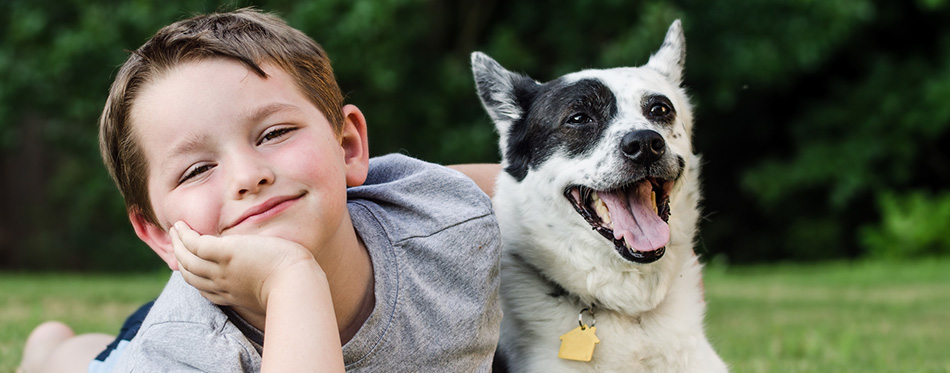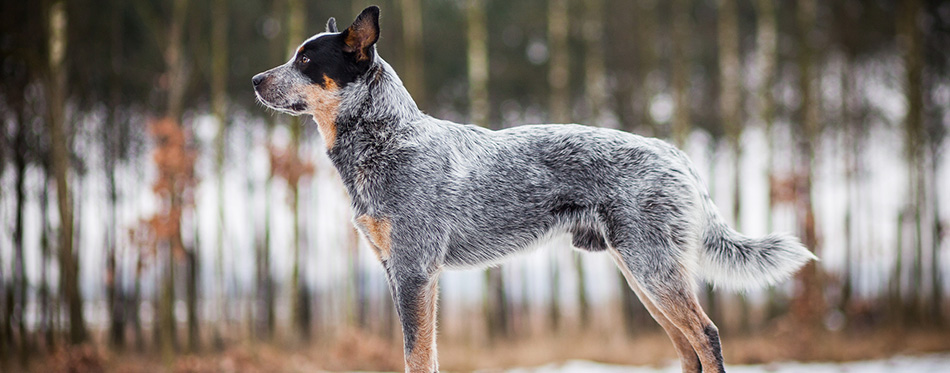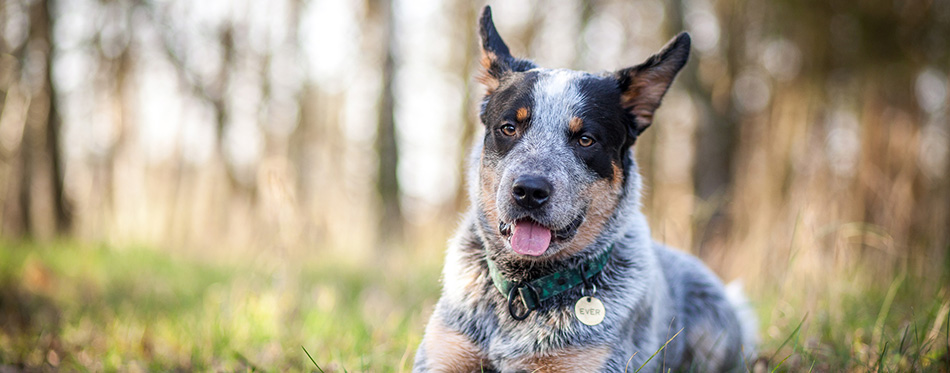One look at the Blue Heeler and you’ll know that this dog is a true working dog. Its medium-sized built is especially bred for speed and agility, nipping at the heels of cattle and other livestock that its master owns. It’s not a handsome dog, not by much anyway. It looks a lot closer to the Dingo, although with a much shorter and rounder muzzle. Known for its fierce loyalty to its master and the accompanying protective nature, albeit to a fault, the Australian Cattle Dog is one of those dog breeds that don’t mind what other people think. For as long as it gets the attention from its owner, the Blue Heeler doesn’t actually care what other folks think about it. The thing, however, is that if you become remiss of your duty to give it attention, you’re bound to discover that this dog can turn your home upside down.

History of the Blue Heeler
Highly territorial and very protective of its human family, the Australian Cattle Dog is more an amalgamation of different breeds of dogs with the characteristics of a good cattle herder – obedient, brave, energetic, cautious, smart, and independent-minded. In the genetic makeup of this medium-sized dog breed are the genes of the Dingo, the Black and Tan Kelpie, the Collie, and the Dalmatian. The resulting breed was one that is highly specific for the Australian Outback.
Cattle ranchers arriving in New South Wales from the British Isles knew that the cattle herders they brought with them are generally unsuited for the long cattle drive across the harsh Australian outback just to get the herd to the Sydney market. George Hall and his fellow ranchers used Smithfields, a type of Old English sheepdog, for the task. Unfortunately, these hounds are only capable of going short distances, not hundreds of miles of perilous terrain. Hall imported Northumberland Blue Merle Drover Dogs to help in this regard. In 1840 these dogs were crossed with local Australian Dingoes which Hall himself tamed to produce what was then called the Halls Heelers.
This is where the confusion begins. Some sources cite George Elliott as the one who crossbred Blue Merle Collies with native dingoes in Queensland at about the same time that Hall developed the Halls Heelers in 1840. Further review of literature revealed that members of the Cattle Dog Club of Sydney, especially Jack and Harry Bagust, further improved on the Queensland Heelers – a name used to differentiate the hybrid from the Halls Heelers – by crossing the breed with a Dalmatian. The resulting crossbreed was then mated to the Black and Tan Kelpie, known for its exceptional working abilities.
The very first Australian Cattle Dog combined the Dalmatian’s faithful protectiveness with the Dingo’s stamina and quiet heeling abilities. News of the effectiveness of these dogs as cattle drivers and herders spread like wildfire and soon became the most prized possession of cattle ranchers in Queensland, using the dogs in huge cattle runs. The dogs were given the name as Queensland Heelers with the blue-colored version as Blue Heelers.
While the exact origins of the Australian Cattle Dog remain disputed, it is clear that it was Robert Kaleski, a young Harry Bagust associate, who developed the breed standards for the Blue Heeler or Australian Cattle Dog. Breed clubs in both New South Wales and Queensland adopted these breed standards and modified it a bit to suit local changes.
In Sydney, Alan McNiven tried to cross a Dingo with a German Shepherd, Kangaroo Hound, and Kelpie in the 1940s to help further improve the breed. Unfortunately, the Royal Agricultural Society Kennel Club refused to register the hybrid as ACD. A cattle rancher from the Napa Valley in the US had met McNiven during the Second World War. Greg Lougher imported many of McNiven’s dogs to the US which were then ‘improved’ by Jack Woolsey. But it wasn’t until 1980 that the Australian Cattle Dog was officially recognized by the AKC, a full 9 months after being recognized by the Canadian Kennel Club, and 5 years before the Kennel Club of the UK.
Following Kaleski’s breed standards, a point that many careless breeders argued, the genetic base of Australian Cattle Dog should always be the Dingo, for very obvious reasons. Only the Dingo had the resilience and stamina needed by cattle drivers in the harsh environments of the Outback. No other dog breed, cross or pure, can match the Dingo’s performance in the rugged backcountry of the Land Down Under.
Quick Facts
The Blue Heeler is a hardy dog that is built specifically to drive cattle in the Outback. It’s well-revered for its cattle-driving prowess and incredible stamina over great distances. To understand more about this breed, it’s important to face the facts.
- Blue Heelers can stand up to 20 inches at the shoulder, although you can always see dogs that are smaller but never smaller than 17 inches.
- These sturdy cattle drivers can tip the scale at 50 pounds with a lower limit of 30.
- Because they are especially bred for the roughest and toughest lands on the planet, they are exceptionally hardy, living up to 15 years with 12 years as the minimum. However, Bluey, an ACD, lived up to 29 years and 160 days and currently holds the Guinness World Record for the oldest dog with a verifiable age. This ACD lived from June 7, 1910 until its demise in November 14, 1939. Talk about resilience!
- Nipping and biting behaviors are highly instinctual; otherwise, they won’t be as efficient in their cattle herding and driving abilities. This trait can be especially risky for children who are running as the Blue Heeler’s instinct is to go after the heels of these running feet.
- The fact that the Outback can be exceedingly hot during the day and bitter cold at night, the Australian Cattle Dog always come with a really dense undercoat covered by an outer coat that is best described as weather-resistant, straight, and short.
- The Blue Heeler doesn’t shed all-year round; instead it blows at least once a year. When this occurs, you’ll have a snowstorm of pet hair right inside your home.
- Australian Cattle Dogs come in two color coats: blue and red, with the former being more popular.
- Blue or Red Heelers don’t require much grooming, although regular brushing and the usual hygiene care are a must.
- These dogs think they are invincible. As such, you can almost always expect a lot of injuries on Australian Cattle Dogs because of their very powerful sense of adventure. Don’t be alarmed, though as the Blue Heeler is, indeed, one tough breed.
- It is a highly suspicious breed, especially to strangers and other dogs. It always thinks that someone or another dog is out to steal its master’s livestock.
- The Australian Cattle Dog is deeply territorial and will stop at nothing to defend its turf.
- The Blue Heeler is a shadow dog. Once it has established a trusting relationship with its pet parent, there’s no place that the pet parent can go without the Australian Cattle Dog following closely behind.
Things You Should Know
It is fairly obvious that the Australian Cattle Dog is not for everyone. It requires individuals with the same high-energy as this breed. Otherwise, it will rule you and your family. It should be remembered that the Dingo is very much alive in the Blue Heeler. You don’t want to mess with these hardened dogs of the Outback.

Training
The Australian Cattle Dog is one of the quickest-learning dogs on the planet. It’s smart and intelligent and can easily pick up what you want it to perform. However, if you think mastering basic dog commands is enough, you’re in for the surprise of your life. The Blue Heeler is bred for long and arduous work. It will still be working when its master is already safely tucked in his bed for the night. As such only advanced dog training programs will work for the Blue Heeler, often at gradually increasing levels of difficulty. Heed this well and you’ll save yourself from many behavioral problems.
A Blue Heeler will listen to a novice dog trainer, why not. But if you want to keep its interest you’ve got to be a seasoned dog trainer to devise a program that will always integrate a variety of innovations in the teachings. Being an intelligent dog simply means your Blue Heeler can get easily bored especially with the same usual stuff. If you’re not up to such a responsibility, forget owning a Blue Heeler or get the services of a professional dog trainer; preferably one with extensive experience working with ACDs.
Related Post: Dog Training Books
Feeding
Current recommendation is to give 1.5 to 2.5 cups of the highest possible quality dog food that is calorie-dense and is high in animal proteins. However, we strongly suggest considering the age of your ACD, its weight, its current health status, its activity level, and its life stage to determine the right amount of calories to give every day. Since these are medium-sized dogs it’s best to feed them twice a day.
Make sure there are enough vitamins and minerals that will support your Blue Heeler’s physiologic requirements. Getting a dog food with glucosamine should help minimize the impact of hip and elbow dysplasia. Providing the necessary omega fatty acids can also help improve eye development as this dog is genetically prone to progressive retinal atrophy.
For more guides on choosing the right dog food, you may wish to check out our reviews of the best dry dog food, organic dog food, grain free dog food, dood for diabetic dogs and pig ears for dogs.
Exercise
We mentioned above that the Australian Cattle Dog is meant to work long hours that it will still be working even when its master is already snoring in his bed. It is a high-energy dog that is designed specifically to run after cattle as they move across the Outback and into Sydney. For them, work is fun.
Now, if you’re the type of person who rarely finds enjoyment in walking dogs, much less running, jogging, or even biking with them you’re in deep trouble if you decide to bring an ACD home. These dogs require at least an hour of vigorous exercise every day. This is on top of its equally-vigorous playtime that should help provide for a more mentally-balanced hound. The exercise requirements for a Blue Heeler are important not only in terms of its physical health, but also its mental wellness. Many behavioral problems seen in dogs can be addressed by keeping them really busy during the day so they won’t have any energy left to carry out their destructive tendencies.
Socialization
There’s a reason why they call these dogs as ‘heelers’. These are specifically bred to go after the ‘heels’ of cattle, nipping and biting the cattle’s heels to bring it to follow the direction of the herd. The problem is that this nipping and heel-biting behavior is already programmed in the Australian Cattle Dog’s genes. There’s no way you can get inside its genetic makeup, identify the nucleotide that is coding for such a trait, and replace it with a gentler one. The only thing you can do is to socialize and train your Blue Heeler straight from puppyhood.
If the ACD puppy grew up around children and was taught to differentiate a running cattle from a running child so that it will not nip or bite at the heels of the kid, then you will not really have much of a problem. ACDs are good with kids since they spent most of their idle time with the children of their cattle rancher families. However, the herding instinct is so great that it’s not advisable to leave your kid alone with an ACD.
While Australian Cattle Dogs are territorial and may not really be all-too friendly with other dogs and most especially cats, if these dogs are socialized with other animals as puppies there is a chance that they will live along peacefully with these other creatures.
Grooming
Folks who dislike grooming their dogs will be happy to learn that grooming the ACD is not very difficult. It doesn’t shed every day, although once or twice a year the Blue Heeler can let out a snowstorm of pet hair. Regardless, just because it doesn’t shed all year round doesn’t mean you’re already free of coat brushing duties. They still need regular brushing of the coat, preferably once a week.
Brushing the ACD’s teeth can be done twice or thrice a week just to help remove tartar that may have already begun to build. The nails can be trimmed once a month. The ears also need to be cleaned on a regular basis.
Check out some of our dog grooming guides, such as dog shedding brush, dog toothpaste, dog toothbrush, dog wipes and dog dryer.
Health
Bluey the ACD may have lived up to 29 years and 160 days, but this doesn’t automatically discount the possibility of inheriting a variety of canine disorders. Chief among these is elbow and hip dysplasia, although patellar luxation, progressive retinal atrophy, portosystemic shunts, and genetic deafness are also quite common.
It’s always best to talk with the ACD breeder to gain an understanding if the Blue Heeler you’re getting has parents that have known inheritable diseases.
To sum it up, the Blue Heeler is near-ideal for those individuals who possess the following qualities.
- Families with children who are at least 8 years of age
- Folks who have a clear understanding of and know how to train and socialize dogs even as puppies
- Individuals who lead a very active lifestyle such as daily jogging, running, biking
- Someone who knows how to engage Australian Cattle Dogs mentally
- People who understand the need for regular canine hygiene, although the ACD is not going to shed heavily everyday
- Individuals who can devote at least an hour of meaningful interaction with the Blue Heeler on a daily basis
In like manner, the Australian Cattle Dog is not well-suited for the following individuals.
- Those with small children as well as smaller pets as the ACD’s herding instincts can be such a powerful tool
- Individuals who are self-confessed couch potatoes or those who simply dislike outdoor activities
- Folks who cannot commit to a puppy socialization and training program that’s specific for ACDs
- Those who hate having pet hair in their homes
- Persons who will leave their dogs alone at home throughout the day

Temperament
Strength and perseverance are qualities of the Australian Cattle Dog revered by seasoned cattle ranchers. The legendary cattle herding stamina and attitude of the Blue Heeler remain strong to this very day. It is best known for its ability to take the initiative. Its cattle rancher master doesn’t have to tell it what it needs to do. It already knows. The Blue Heeler loves nothing more than to learn and work with those that it loves. And when it comes to its loyalty, nobody can question it. It will protect you from anything or anyone that it perceives as a threat. Highly suspicious of others, the Australian Cattle Dog can nevertheless live in harmony with kids and small pets if it grew up fully socialized with them.
The Blue Heeler is definitely not a dog that is suited for anyone. But, if you’re committed to training and socializing it as a puppy, giving it plenty of ‘work’ to do, then the Australian Cattle Dog just might be the right dog for you.
Sources:
- Australian Cattle Dog Breed History – Australian Cattle Dog Club of America
- Australian Cattle Dog – AKC

